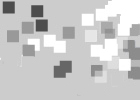The three pages in this
section will briefly discuss the technologies and crafts that are most widely
used to create NET.ART. These brief comments and definitions are not intended
to be complete explanations. Links are provided if the reader wishes to pursue
these topics in more depth.
The Digital Image
Reduced to its basic form the digital image is made up
of thousands of dots known as pixels (picture elements). These
are generally thought of as the smallest element of an image. Pixel
manipulation is one of the primary tasks of the digital artist and is the basis
for almost all image manipulation. The list software that is available to the
digital artist is almost endless and growing almost daily. Software companies
like Adobe, Macromedia, Corel, Alias and hundreds of others
make products for photo editing, digital drawing, animation, 3D art and
animation, video creation and hundreds of other artistic functions. The digital image is at the heart of most
net art. The artist that uses the internet as a conduit to display his
handiwork will doubtless be skilled in the design, creation and manipulation of
these images.
Click
here for an in depth discussion of pixels.
Click
here for information on Pixel Art.
There are two basic types of digital images, Raster
and Vector. Understanding the primary differences between these two types of
images is an elementary in understanding the digital image. Raster images are
also known as bitmap images. As the name implies this type of image is created
by digital mapping. A rectangular grid is mapped bit by bit to determine the
characteristics of each pixel. This image can then be reproduced by using the information
from this digital map. Raster images are best suited for photographs and high
quality graphics.
More Information on Raster
Graphics.
Vector graphics are created by using mathematical formulas
to determine the location of points, and to determine how those points are
connected using lines or curves. This is also known as geometric modeling. The
shapes created by this method can be filled with colors, gradients or patterns
to create images. Vector images are best used for geometric shapes, simple
cartooning and composite drawings. Because vector images do not require
bitmapping the file size is typically much smaller than a raster image of the
same dimensions. This makes vector images a good choice for simple 2D animation
that must be transmitted over a connection with limited bandwidth.
More Information on Vector
Graphics.
There are three graphic file formats that are
universally recognized by nearly every web browser on the planet. These are
commonly known as The Graphics Interchange Format (GIF), Joint Photographic
Experts Group (JPEG) and Portable Network Graphic (PNG).
More Information
on Graphic File Formats
GIF is a lossless compression format. It is the
oldest graphic file format on the Web, and consequently has excellent browser
support. The GIF compression format support up to 8 bits per pixel, which means
a maximum of 256 colors (Compression: Optimizing Web Graphics).
JPEG is a lossy compression format. It is designed
for compressing either full-color or gray-scale images of natural, real-world
scenes. It works well on photographs
and lifelike complex artwork. JPEGs support 24-bits of color allowing for 16.7
million colors. JPEG images are supported in all modern browsers (Lane).
PNG is a lossless format that uses full color support and
error detection. It can store detailed, complex images without data loss. It
works well with photographs and lifelike artwork. The PNG format is not
supported by all browsers (Compression: Optimizing Web Graphics).
Graphic Arts
“The modern graphic arts
industry is on the cutting edge of innovation in digital imaging, data
management, computer technology, and telecommunications.” (Learning Center).
Graphics are the most common type of art on the net and are an essential of all
forms of NET.ART. Michael Rush noted “…graphic design plays an integral role in
this developing art form.” (p. 197).
Design is an integral part of the artistic process and graphic artists
and designers create the majority of the internet art that is produced for
commercial websites. Rush also observed that “…computer graphic artists…assist
visual artists from other media in adapting to the computer.” (p. 197).
Website Design
Despite some opinion to the contrary the craft of web
design has evolved into its own artistic domain, or perhaps a sub-domain of
NET.ART. It is not uncommon for a single web page to contain photographs,
animation, images and text. Each medium carefully arranged on this electronic
canvas and combined with color to present a specific type of look, feel and
aura. The use of text as an art form is not a new idea. This has been done in
logos and advertisements for centuries. But the webpage is unique in the fact
that it combines all these mediums as an attractive interface for generic and
often changing text. The design and creativity of a web page will greatly
influence the impact the page has on the reader. This new artistic procedure,
like most disciplines, has developed its own language and tools. Terms like
Stickiness (which refers to how long an individual user stays on a web site)
and Eyeball Hang Time (which is a measurement of website loyalty) are examples
of this new language (Manovich, p. 161).
The tools and technologies of the website designer include What You See Is What
You Get (WYSIWYG) website development software programs, File Transfer Protocol
(FTP) programs, Java and Javascript, Hypertext Markup Language (HTML), Dynamic
HTML, Extensible Markup Language (XML), Virtual Reality Modeling Language
(VRML), Visual Basic, Active Server Pages (ASP) and an ever growing list of software
and internet technologies.


